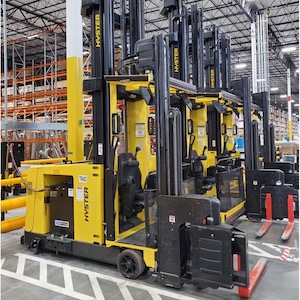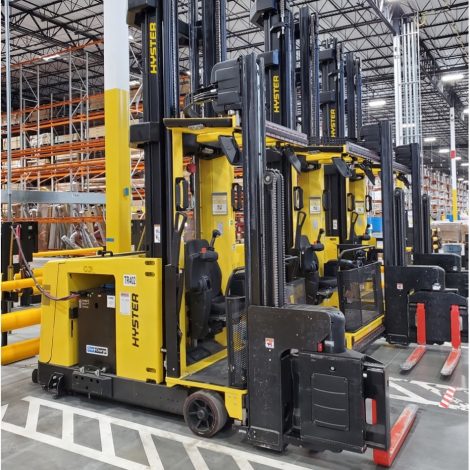
Integrated and modular battery packs
Following many decades of engineering evolution around the only power-source technology (the lead-acid battery), electric lift trucks and forklifts have finally adopted a new power source: lithium-ion battery packs. The benefits of lithium solutions are well-known by now: higher performance, less maintenance, and improved sustainability. Lithium batteries provide a better return on investment and enable the use of automated guided vehicles and mobile robots (AGVs and AMRs), which rely heavily on durable, ”hands-off” lithium batteries.
Now that lithium batteries can become an integral part of a lift truck, there is also the option of using a third-party modular lithium battery pack made by a specialist company. Will an integrated or a modular battery pack become the standard? This question turns out to be pivotal for the future development of material handling equipment.
In consumer devices powered by lithium batteries (like cell phones) an integrated battery is a standard choice today. A user does not need to pick and choose among multiple options or perform any maintenance on the battery; one size fits all users. But with professional tools and equipment, a modular detachable battery usually does a better job. This approach is relevant to material handling equipment.
Integrated lithium forklift batteries

Modular lithium batteries power a broad model range of material handling equipment.
Lithium systems are winning because they can better serve individual customer needs, and allow for a much greater degree of customization of material handling equipment. A single forklift model can be used to operate outdoors or inside the facility, perform all its functions in extreme ambient temperatures, or use powered hydraulic attachments instead of a regular fork—all because a modular lithium power system can be adjusted for each operation. Electric forklifts powered by lithium batteries can now be used in applications where only diesel and propane-powered trucks were once used.
The first lithium integrated trucks by BYD and Linde came to the market back in 2014. However, the sales numbers of forklifts with integrated Li-ion batteries are still in double digits in 2022 when battery specialist companies are selling thousands of lithium units each year. What is holding back the lift truck manufacturers?
Cost
Forklifts with an integrated lithium battery would be higher in price than a regular electric forklift with a lithium battery from a battery specialist company. Buying a lift truck with an integrated lithium solution can be twice as expensive as an electric forklift with a US brand of an industrial lithium battery pack.
Product line
Very few businesses on the US market can be considered “standard.” Many traditionally operate over multiple shifts and weekends. The current low number of models of lift trucks with an integrated lithium battery pack is not encouraging the use of these trucks in applications with non-standard operations, which often require a higher battery capacity to power attachments, move and lift heavy loads, or support longer hours of operations.
Some European brands of lithium-first forklifts (such as Jungheindrich) may be popular in their home markets, but have lower traction in the US precisely for this reason: a “standard” Ah capacity across a few models in their product line. In many cases, customers need “more gas in the tank”, and these batteries are only available from a specialist lithium battery manufacturer, such as POWER Series by OneCharge.
Ergonomics
“Built around the battery,” these trucks can reduce the battery compartment, as the lithium battery pack is much slimmer than lead-acid. This leaves more space for the operator’s cabin, providing more leg-room and making it easier to enter and exit.
One important benefit of an integrated lithium battery: the truck is designed with a lower center of gravity, which improves stability, maneuverability, and speed. These forklifts can safely handle heavier loads with lower counterweight requirements.
Integrated charger
Some of these forklifts come with an inbuilt 110V charger. It is useful when equipment needs to be carried around and the MHE has to be charged outside of its home facility—for example, a pallet jack that is used in box delivery by a commercial truck.
A 110V charger with an output of 20–50 Amps is not powerful or fast enough when it comes to a bigger battery. Fast, efficient charging will certainly require a more powerful external charger. Class I and II lifts typically use 480v 3-phase chargers that put out 120–300 Amps.
IP65
Ingress protection against water and dust is essential in some operations and is a really useful feature. In many cases, like in meat/fish processing plants, the material handling equipment also needs to demonstrate top performance over multiple shifts in low ambient temperature. The advanced insulation of the FROST package, which keeps the battery warm, combined with high capacity to support the long hours of operation only comes with a specialized lithium battery and is not on the menu with forklift OEMs.
CAN integration
It is important that all three elements of the equipment—the forklift, battery, and charger—are fully integrated to maximize efficiency and safety. One engineering solution could be to create a locked system. But you can also make all elements universally compatible!
The truck’s controls and indicators use the battery data and improve the operator’s safety. Seamless CAN integration of a battery and charger provides maximum charging efficiency and minimizes the loss of energy.
Integrated lithium solutions provide all these benefits in locked systems, but so do batteries and chargers approved by OEMs. In fact, some OEMs outsource batteries for their systems, offering the same model you can buy on the market as part of its branded (and more expensive) “lithium-first” solution.
All customers would certainly benefit from the development of universal standards for CAN integration of batteries with lift trucks and chargers. Closed systems stifle competition and drive up the price. No one is happy with a cell phone locked to one operator, and an expensive charger with a unique connector.
The future of forklift-integrated lithium batteries
The energy efficiency of material handling equipment is bound to greatly improve with the advance in higher voltage forklift batteries (in the ballpark of 400V). However, apart from safety issues, the main barrier for manufacturers today is the availability of a whole range of electric components. The electric system will need to be re-engineered to reliably support a voltage this high.
The future of integrated lithium solutions is very promising. But before the benefits of lithium technology can be fully utilized, major OEMs will need to really redesign the trucks around this new power source, whereas drop-in solutions will remain more efficient and economical in the next few years.
Drivers and limiting factors for the adoption of forklift-integrated lithium battery solutions compared to modular battery brands.
| Modular batteries | Truck-integrated batteries | |
| Number and choice of models | Wide range of models (see our North American Lithium Battery Market Review), and customization for specific applications. | Limited choice of models, no customization. No flexibility with battery options, such as low-temperature package, range of A/hour capacity. |
| Price | Competitive pricing from several battery brands, approved by and independent from the truck manufacturer. | Up to 2X higher price than the same truck powered by a specialist lithium battery brand. |
| Charger CAN integration | Full truck–battery–charger (CAN) integration is offered by some brands. | Full truck–battery–charger integration under one brand, “big company” warranty benefits. Potential for implementing auto industry high-voltage battery standards. |
| IP65 protection | Optional with any battery model. | Guaranteed in some models (and included in the price), but not available in other models. |
| Truck engineering design | Most trucks were designed around old lead-acid batteries, not optimized for the lithium power pack. | A lower center of gravity can provide a higher load capacity for the truck. Improved ergonomics: more legroom and easier entrance and exit for the driver. |
| End-of-life equipment repurposing and residual value | Forklifts are leased or bought independently from the batteries, and can be sold or repurposed at any time. Lithium batteries can outlast the host vehicle, preserving a certain residual value. | Limited choices of the equipment re-purposing at the end of the lease. The high price makes it hard to sell used forklifts with integrated batteries, and even harder to sell separately. |
 by Tim Karimov | mai 26, 2022
by Tim Karimov | mai 26, 2022